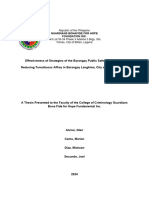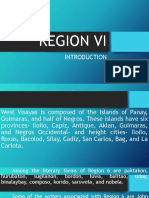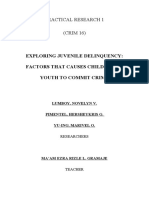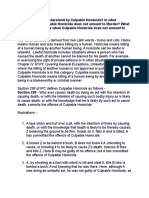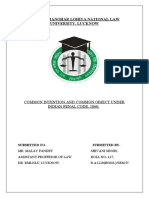INTRODUCTION
The year was 1993. One of the crimes that captured the attention of the entire nation was the
gruesome murder of “The Chop-Chop Lady.” The name, of course, came from the fact that the
victim’s body was dismembered before it was thrown away.
Then, on a 1967 summer's day, Lucila vanished. It was not indicated in any of the historical
newspaper articles whether Lucila's friends or relatives filed a missing person's report. It seemed
to be an open secret that Lucila had other lovers, so perhaps that's why they assumed she was
just hanging out with them. Lucila Lalu went missing on May 28th, 1967.
Police discovered human remains on May 28. Specifically, they discovered a woman's legs, neatly
sliced into four sections and wrapped in a May 14 newspaper. The legs were discovered in a trash
can near the Pagoda on Malabon Street. The components were located by a waste collector, who
said that they felt chilly to the touch, almost like they had just come out of the freezer. In addition,
he saw that the toes had excellent manicures, suggesting that the owner was well-off.
A torso with arms was discovered close to the Guadalupe Bridge on EDSA almost a day later.
Newspaper, dated May 23, was used to wrap these components as well. It was determined that
the body belonged to Lucila since her fingerprints were on file from when she first arrived in Manila
and requested for a police clearance. Since the components were carefully chopped, homicide
investigators concluded that Lucila's killer was either a proficient knife user or had some medical
knowledge. According to the first reports, they were also searching for someone with access to a
large freezer and a car because the body parts were frozen and dispersed throughout the city.
The official investigation concluded that Lucila died either early on May 29, 1967, or late in the
evening on May 28, 1967. She was one month pregnant when she passed away. The authorities
were in a frenzied attempt to find her killer and her head once the news broke.
Most of Lucila's lovers were among the several suspects that were apprehended. First there was
Florante Relos, a 19-year-old Pagoda waiter Lucila had helped. But Florante was released since
he was out drinking with his companions at the time of the incident. Furthermore, he had no
reason to murder Lucila, his provider and love interest. She even arranged for him to remain in a
"love nest" in Cubao. But the Pagoda cashier also mentioned that Lucila and Florante had already
broken up. She also informed Florante and his buddies that Lucila might be at the beauty salon if
they wanted to see her on the night of the murder. In front of the parlor, some witnesses even
claimed to have seen her being dragged by Florante and his friends into a taxi. These reports
were never checked out.
She even arranged for him to remain in a "love nest" in Cubao. But the Pagoda cashier also
mentioned that Lucila and Florante had already broken up. She also informed Florante and his
buddies that Lucila might be at the beauty salon if they wanted to see her on the night of the
murder. In front of the parlor, some witnesses even claimed to have seen her being dragged by
Florante and his friends into a taxi. These reports were never checked out.
Aniano stated that they had dinner together in the beauty parlor about 6:30 p.m. on the night she
vanished. He departed right away. Witnesses, including some of Lucila's family members, claimed
to have even seen her asleep at the salon at the time Aniano left. This, however, runs counter to
Florante's previous statement that he and Lucila had met in another cocktail lounge on Rizal
Avenue at around 7:30 that same evening.
�An executive of a printing company who was also rumored to be Lucila's lover was another
suspect. He was only mentioned as being suspected in relation to a cardboard material that had
been used to wrap newsprints and was discovered beneath Lucila's chest in none of the reports.
There was no more investigation done on this mystery man's apparent alibi for the evening.
The final suspect was a 28-year-old dental student named Jose Luis Santiano, who came forward
because he felt he had a "guilty conscience." On June 15, 1967, word leaked out that a
"handsome young man," married, with five children, and the son of a former PC colonel, had
admitted in a handwritten confession that he had gone through a "mental blackout" but that he
did, in fact, remember choking Lucila to death. In addition to being a boarder at Lucila's parlor,
Jose Luis was one of her lovers.
He said in his first testimony that Lucila had attempted to woo him and had threatened to cause
a scandal if he refused. At this point, Jose Luis went insane and killed her. He even went so far
as to say in his testimony that the head was disposed of in Diliman, Quezon City, and that portions
of the body were transported in paper bags and boxes while riding in taxis and jeepneys. Jose
Luis claimed to have kept the body till disposing of it, and under his bed, police subsequently
discovered dried blood evidence. If the head was ever located, it was never mentioned in historical
news reports.
Jose Luis was singing a different song three days later. He later withdrew his previous claim,
claiming that he was only a "unwilling witness" to the murder, which was actually carried out by
three guys. Jose Luis claimed that two men killed Lucila while a third guy kept him captive and
pointed a gun at him, even though the murder did indeed take place on the mezzanine of the
parlor where Jose Luis' room was located. The next morning, a fourth man showed up and left
the blood—evidence—in his room. He also allegedly received notes over the next three days
asking him to be silent.
Given that they discovered bloodstains on a hammer on the mezzanine and that Jose Luis had
used a knife and razors in his original testimony, the police were adamant that Jose Luis was the
one who did it. They asserted that he was only acting on his attorney's advice to take back his
remarks. Additionally, the NBI received bomb threats to release the murder suspect while Jose
Luis was in custody. Later on, he was freed, and some people even claim that Jose Luis is still
alive and residing overseas.
The detectives came to a standstill in the absence of any fresh leads. On the other hand, the
enigma remained a subject of public speculation. Black Dahlia Avenger: The True Story, written
by retired Los Angeles police detective Steve Hodel, was released in 2003 and details a 1947 US
case that was comparable. In the book, Hodel describes his 15-year search for the Black Dahlia
murderer—whom he believed to be his father, Dr. George Hill Hodel—following his father's
passing.
When Steve Hodel's father was in Manila in the 1960s, he came to assume that George was also
responsible for Lucila's death during his inquiry. His book did contain certain errors, though. For
example, it said that Lucila's torso was discovered in Makati along Zodiac Street, whereas news
sources said it was discovered near Guadalupe along EDSA. Although the murder of Lucila can
be explained in this way by certain mystery enthusiasts, the case is still pending.
� CONCLUSION
The absence of proof led to the suspects' release. Florante Relos, the first suspect, was
later freed since there was insufficient evidence to link him to the crime. Because Aniano left
shortly after their supper and witnesses, including members of Lucila's family, claimed to have
even seen her dozing in the salon at the time Aniano left, the second suspect—her common-law
husband—is likewise not being investigated. The strong alibi of the unidentified suspect prevents
any further investigation. Unanswered questions arose, such as the identity of the CEO from the
printing company who was meant to be the fourth suspect. Why has no one been able to identify
him? Was that, in fact, Dr. George Hodel? The final person is Santiano, who was freed after
suffering brain damage in a bombing in the 1950s. Neither of his claims to the police seemed to
be genuine.
Because this case, one of many unsolved cases in the Philippines, has not been resolved,
I believe the government to be incompetent and a failure. If the police had followed up to do an
investigation, this case would have been resolved long ago. They had four suspects, but they all
managed to escape, so even though they had the opportunity to look further, they chose not to.
There is a significant gap in the case because they leave us with a lot of unanswered questions.
The police appeared quite determined at first, but they quickly lost interest. Were bomb threats
the reason for this? Pay bribes? or simply plain carelessness. Additionally, people grew so naive
that they came up with multiple proposals to develop a movie based on Lucila's case. a victim
who was butchered, and her head hasn't turned up yet. It is too late to solve this issue; many
other cases remain unresolved, which I surmise is a result of our nation's subpar legal system.
REFERENCES
A case analysis: Lucila Lalu case
https://www.studocu.com/ph/document/nueva-ecija-university-of-science-and-
technology/bachelor-of-science-in-business-administration/lucila-lalu-case-analysis/58903176
The Grisly History of “Chop-Chop Ladies”
https://www.esquiremag.ph/culture/lifestyle/chop-chop-ladies-a1729-20180830-lfrm4
Lucila Lalu & Elsa Castillo: The Philippines’ “Chop-Chop Ladies”
https://www.pep.ph/news/local/171838/lucila-lalu-elsa-castillo-chop-chop-ladies-a734-
20230301-lfrm
























